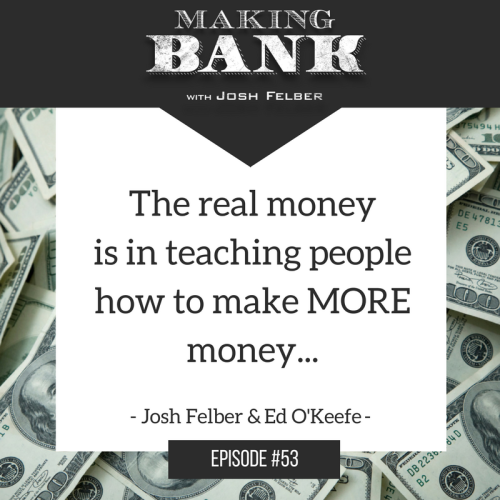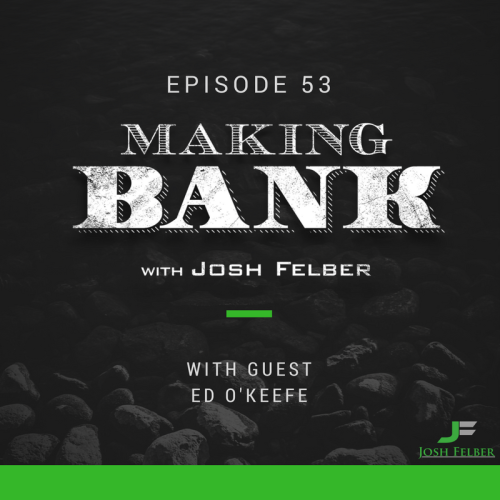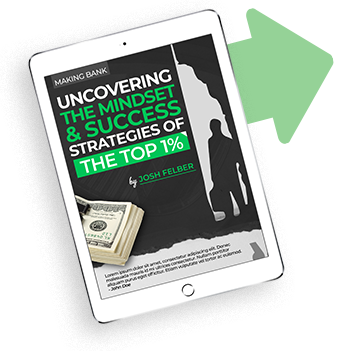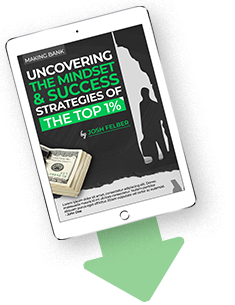Learning How to Market Yourself with Guest Ed O’Keefe: MakingBank S1E53
with Ed O'Keefe
Video:
Audio:
Click here to get Free Podcast on iTunes
SUBSCRIBE for weekly episodes and bonuses: bit.ly/JoshFSubscribe
MAKING BANK is now a weekly YouTube TV show and iTunes Podcast full of #Success and #Business with Josh.
Subscribe to the Podcast MP3: bit.ly/TumblrSubscribe
Summary
Imagine being dead broke (or maybe you don’t have to imagine it because you’ve lived it).
Imagine the fear. The anxiety. The looming dread of—is this it for me as an entrepreneur?
What would you do in that situation? Would you throw in the towel, go get a “regular” job, and settle in for 40+ years of the 9 to 5 grind?
Or would you keep pushing the envelope? Keep chipping away at the idea-block until—one day—you cracked the code of success?
It might sound like a feel-good Hollywood drama, but it’s not—it’s the real-life story of serial entrepreneur Ed O’Keefe, a Southside Chicago-kid who went from worrying about his last few hundred bucks in the bank to launching multiple seven (and even eight!) figure businesses like Marine D-3 and InspiredWear.
Ed’s story is a story familiar to so many other successful entrepreneurs. A story where idea after idea fails to get off the ground, not because the ideas aren’t good, but because the idea-maker doesn’t know how to market, promote, and sell themselves.
It took Ed years of struggle to learn how to promote himself, and find his professional niche as a marketer, but since finding it he hasn’t looked back.
Today, he’s more than a super successful-entrepreneur, he’s also a business owner, business strategy coach, consultant, advisor, TV show host, author, husband, and proud father of seven.
His latest accomplishment, Time Collapsing—The New Art of Speed, Money, Power, and Meaning, is an in-depth exploration of the behind-the-scenes system, Ed has used to sell almost $100,000,000 in services, consulting, supplements, seminars, and informational products.
Sit-down and strap-in for an entertaining exchange between Ed and Making Bankhost, Josh Felber, as they cover critical concepts every aspiring entrepreneur needs to know.
Concepts like…
• The value of teaching others how to make money
• Living with purposeful intent
• Why “having goals” is overvalued
• Hours worked does NOT tie into success
• The danger of getting stuck “in” problems
• Why now is the best-time EVER to become successful
…And much, MUCH more.
SUBSCRIBE for weekly episodes and bonuses: bit.ly/JoshFSubscribe

Transcription
Josh: Welcome to making bank. I am Josh Felber where we uncover the secrets of the strategies of the top 1% so you can move your life and your business forward. I’m excited today. I have a really awesome guest with me. Let me tell you a little bit of background who he is. He’s an entrepreneur, an author, and a speaker. Most importantly just like myself, he’s also a father of seven. I’m only of three.
Ed: I was like, “Dude, when did you get more children? That’s pretty amazing.”
Josh: I’ll clarify that. He’s gone from dead broke to cracking the code from starting and taking multiple businesses from zero to multiple seven figures as well as even eight figures. He and his wife raise their kids in the south side of Chicago and he’s just launched an awesome new book and an event overall called The Time Collapsing: The New Art of Speed, Money, Power, and Meaning. I’m excited to welcome Ed O’Keefe to Making Bank.
Ed: Hey, Josh. Thanks for having me. Hi everyone. Toked to be here. I’m very excited to be here. This is pretty exciting. Glad you got the book. We’re ready to rock and roll.
Josh: Definitely man. Let’s fill in our guests a little bit on your background, how you got started as an entrepreneur.
Ed: Sure. My background is pretty simple. It’s actually pretty funny. I grew up in a family of 13 kids. I’m the 12th of 13. I was the first one to graduate from college. I graduated with my nursing degree. Probably like a lot of listeners or viewers, I came across some audio tapes from Earl Nightingale on Lead the Field, Dennis Waitley, A Psychology of Winning. Right around that time, I think I was in my early 21, 22, Chicken Soup for the Soul became very popular. My mind, this was the first time that I had ever been told that you can go out and do whatever you want to do. You can become an entrepreneur, you can live your dreams. You live in the best country of the world.
That was so brand new to me. I was on fire. It really lit me up because I was like, “You know, this resonates with me.” Like a lot of your viewers, I was like, “I have something bigger out there for me.” When i graduated college, I said goodbye to nursing, got my degree, but didn’t go into it and started off on this journey of failing a lot, really lot as I through mentors and self-education through books and trainings like this, really experimented my way through to where we are today.
Josh: What was that first business that you started? How did it go?
Ed: The first thing is I thought I was going to be the next Tony Robins motivational speaker. I was like, “He was young. I’m young.” I was really excited about that, but I didn’t know how to market and promote myself. I’m giving you kind of the quick version of it, but for four, four and a half years after college, I was bar tending. I was coaching volleyball. I was speaking when they would let me speak. I was doing whatever it took.
I had written a book or two. It wasn’t until I discovered, “You need to learn how to market, promote, and sell.” Primarily we utilize … All my companies do direct response marketing. That was the point where I realized, “Wow, if I can learn this concept of being highly leveraged, create a 24/7 cash machine, which I call a time collapsing cash machine, I could have life freedom and I could run life on my own terms. It wasn’t overnight success, but it definitely … I saw the pulse and we started going from there and really started hammering down.
Josh: Awesome. Fast forward a little bit, what have you done that led you to your most success?
Ed: Yeah, so what I did was I transitioned out of speaking and I took my trainings and I created manuals out of that. That’s where I kind of learned to write direct response sales copy, understand the mechanics of business like, there’s only three ways to grow a business. What are those things? Then I noticed that I was never going to make the amount of money that I wanted to make selling to volleyball coaches and soccer coaches manuals. The real money was figuring out … At that time I was like, “If I could teach a market how to promote and get customers or patients or whatever, I could help them make money.” It’s easy to sell people to exchange money when you can make them more.
Hey, you should pay me 1,000 bucks. Why should I pay you 1,000 bucks? Because I’m going to show you stuff that will increase your income by 100, 200, 300,000 this year. Would you pay 1,000 bucks then?
That sales proposition, I went into the dental field. I was kind of crazy, moved over to the dental [inaudible 00:06:30]. I was there for about nine years. The next big transition that had another big success was when I went to the health supplement business market. In the coaching business and dentistry selling information stuff like that, just to give everyone a view, we sold probably over 50-60 million dollars in information, coaching, seminars, and then when we went to the health supplement business the next 5, 6, 7 years was over 50 million again pretty easily. We still do a few million a year in that business. Then obviously the time collapsing stuff which I’ll talk to you about in a few minutes.
The same principles apply. Once I figured out the principles, it was just a matter of getting better at them and shortening the gap of running through that cycle which everybody can apply. That’s the big point.
Josh: Tell me with as you were growing, you created the dental business as well as supplement company and everything. What do you think was one or two factors that led you to see those to be both successful?
Ed: I think first and foremost, Josh, everybody who’s on this, there has to be a mental … This is where time collapsing … One of our key words in time collapsing is, there’s a couple that I like to share. One is we never chase, we always attract. The business is designed to have customers or patients, specifically online because that’s where I run most of my businesses or seminars. We never chase people. They come to us. When we design out marketing, our PR strategy, our book, everything is designed with a strategy that has a business behind it. Otherwise, you’re just pumping out content or you’re doing activities, you’re going to networking events, you’re doing things without purposeful intent.
That’s fine when I guess you have a lot of time to waste, but it’s not fine when you’re really trying to create the highest fulcrum and highest leverage points in your life. That’s one. Number two is how do a 26 year old guy go into the dental profession where most of the dentists were 10, 15, 20, 30 years older than me and all the sudden become an authority? I think that’s where the mindset shift of leapfrogging … I talk about this in the book. You have no moral right obligation to work your way through the ranks. At any given point, you can jump to the top of any market or endeavor and claim your spot. That’s from Robert Ringers book Winning Through Intimidation written in 1976.
The main hammer to or the main point to hammer home is for you to make an extra 300, 400, half million dollars next year or an extra million or to be a dominate marketplace leader, no one is going to show up to give you permission. You’ve got to claim it and do that. I do that in every endeavor and we do that again today. Those are two big core operating principles.
Josh: Obviously part of it is when you have a family of seven, it’s like you really got to figure out a way to integrate, I try not to say the balance because there’s no real ever balance because one side is always going to be skewed. I try to look at it as integrating. It sounds like some of the principles that you’re starting to talk about from time collapse and the things that you’ve done over the years has allowed you to create that integration of what you do from a business perspective and family as well.
Ed: Yeah, we always talk about … Something I was thinking about a lot today was tactics. Everyone online right now is teaching tactics. “Here’s your next Facebook trick. Here’s your text instagram trick or YouTube trick or how to get more video views or whatever.” Then we have other experts that are just telling people to hustle more, spend more time.
When I ask an audience, “How many of you would like more tactics on your to do list? How many of you think you’re not hustling enough?” No one raises their hand. They don’t want more stuff to do. They don’t feel like they’re under hustling. The question is then well how do I get a leap in results without figuring out the next weird trick?
Josh: Can we take a quick break?
Ed: Oh yeah, man. Yeah.
Josh: We’ll save this good piece for next. I’m Josh Felber. You’re watching making bank and we will be right back.
Josh: Welcome back to making bank. I’ve had the privileged today to speak with Ed O’Keefe who has recently launched and from practicing his principles over the years the art of time collapsing. Ed was just diving in a little bit about how we’re integrating family and business and we’re talking a little bit about the hustle and nobody wanting to raise their hand thinking that they don’t hustle enough as well as not wanting more tactics on their plate. Ed, welcome back to making bank. I definitely want to hear where we’re headed with this story.
Ed: Yeah, yeah. Thanks. Great tactics will perform exceptionally well in the proper context, right? A lot of guys go, “Hey man, I’m doing the same thing this guy’s doing, but it’s not working for me.” A lot of that is because they don’t back up a step and go to what I call the world view level or structure. When you ask how do you work life integration or how do you become a high performer, when you are a busy parent or mother, father, whatever it might be, what I always like doing is backing people up and saying, “Let’s pretend we have no limitation. You have no money previous obligations you’ve made, constraints you’ve put on yourself. Let’s swipe them all away clean and you tell me what you want your life to look life in three months, six months, one year, three years.
The reason we do that is because most people are stuck in their problems. They have a lot of stuff going on. It’s very hard. You can’t outwork your inbox. You have to design a different life, not a different life, not saying everyone’s screwed up. You’ve got to design your life and then build the business secondarily or even thirdly. Design your life. Where does your family come in? What money do I want to make? I think where a lot of people start having mistakes is they go, “Now I’ve got to limit my potentiality because I have these things.” It’s just wrong thinking. It’s ingrained in us. “Now you’re just in those years, you’ve got to just deal with the family stuff, or you’ve got to sacrifice family.”
I was actually interviewed in an entrepreneur magazine. They were like, “How do you spend time with friends?” I said, “I have a couple of rules. One is I only do business with people I like.” My strategic relationship or vendors, everyone we talk to are people I like. All my customers are people I like. At the end of the day, my friends are somewhat integrated. Then you’ve got your close local friends or college friends, or at the Parish. Then you just see them there.
I think that question comes from a world view of there’s limited time, there’s limited resources. You’re supposed to work 16 hours a day. I flip that on its head and say it’s not true at all. Let’s design it the way you want to design it. Then we back fill the tactics. Tactics are important, but only after you’ve figured out the first three points.
Josh: Definitely. I think like you said, I just saw something about this. Somebody was talking about the hustle and getting out, you’ve got all these people hustling, but nothing is happening.
Ed: A lot of busyness. There’s this busy disease in our society that, “Hey the busier I am, or the more overwhelmed I am, the more successful I am. It must mean I’m more successful.” The answer is no. You’re just completely disorganized and you have no clarity.
Josh: Right, I’m glad you said that. That’s where I was going. It’s that lack of clarity piece. I think what you said a few minutes ago is knowing how you want your life, knowing where you want to go and having that clarity, that mind, that vision helps allow you to start to put those pieces in place to now if you are hustling, then you are driving towards what those angles are whether it’s more time with the family, whether it’s a certain size of business, whether it’s x, y, z.
Ed: Hey Josh, real quick. I’m not against hustling. I hustle my butt of, but I hustle it … If you think about it, the one thing they talk about how the domino theory where the first domino can knock over a domino twice its size. Then the second domino can knock over a domino twice its size. This can exponentially keep happening. We have to do … Everybody who’s listening, watching, we have to step back and really go, “Is it okay for me to sit here by myself with a pen and pad of paper and list down everything that I want to achieve?”
In chapter four in the book, we call it freedom question. Really just say, “Wouldn’t it be great if?” Go through every area of your life and then lay out all these things and really step back and be like, “For this to happen, what is the one thing or two things that if I knocked this thing out of the park, if I focused daily in this, every other goal I have would be easily attained because they’d be a bi-product of this.
For all of us, it’s a little different, but there are patterns. There are patterns that all of us face. If our sales funnel doesn’t work, it doesn’t matter how much content you’re putting out. You’re just accelerating the rate at which a lot of visitors come to a bad sales funnel. If you’re spending money on advertising and your sales funnel doesn’t work or your sales process or you don’t have any back end strategy, you’re just going to speed up the rate at which you go broke.
I consider that … In every business I run, after I figure out the lifestyle thing, my first domino is after I figure out what we’re offering and what we’re selling, the first domino is how do we profitably bring customers into this thing and then how do we leverage that and systematize it so I or you can not stress about getting up and hustling that day. If my wife says, “Let’s go out to breakfast, let’s get my workout in then we’re going to go eat.”
Do you know what I did today, Josh? This sounds like I’m bragging, but I just want to share this with everybody because this is what I’m talking about from a lifestyle design. Last night, I was putting my eight year old to bed. It took me a second, I had to figure out which one. I stopped by all their beds.
Josh: Which order.
Ed: I had to figure out which one I was talking to. Keegan, I said to her … When they’re over tired, they start making up things to not have to go to sleep. We had a teacher parent orientation. She said, “You didn’t put a heart in my bucket,” which they have these kindness buckets. I’m like, “Keegan, I wrote you a long letter and I stuck it in your dresser.” She’s like, “Yeah, but everyone else got these notes.”
So today on my way into the office which was at noon because I went and worked out, I got destroyed by my workout, so I waited a little while to eat, I drove by the school, snuck into her room while she was in there, dropped off the thing, she saw me, came and gave me a hug. Now I left.
It’s just a little, “Hey Keegan, I love you. You’re the best.” That’s what I’m talking about of life freedom. It’s because I designed a time collapsing money machine.
Josh: I think it’s definitely important. We share a lot of the same philosophies. When you travel, conferences, things like that, you’re in and out like me. It’s strategically designed that way for a reason. I know one of the things when I was going through your book is you talk about modeling in there. For me, I’ve been a big proponent on modeling when I first heard about it at 13 reading Tony Robbins. I guess maybe expand on your whole philosophy behind that and how that’s helped you.
Ed: Modeling is misunderstood by a lot of people when you look at real world modeling. I love modeling. I consider myself … Time collapsing, a big proponent is modeling. Then you iterate after modeling. What is modeling? Modeling is simply the replication or the assimilation of someone else’s world class skill or outcome or capability.
If you see an author you want to be more like, you go study them. You see an entrepreneur or if anyone could create the results, the core underlying belief system is if anyone can create this result or solve this problem, I can replicate the process that they did in order to then replicate the outcomes. Here’s their couple key components of modeling though that I think are misunderstood. Number one first and foremost, this is one reason why a lot of business owners fail when they try and model because they don’t get some of these criteria. Thanks for bringing this up.
Number one, you have to have a model that you’re passionate about modeling, that you are really vested and like, “Man” … This is kind of where the freedom questions leads to your model. “Wouldn’t it be really cool if I could work five hours a day, make a million bucks in net profit, be at my kids games?” If that’s your thing. That’s number one. You have to be … When I see my models, I have to be ridiculously passionate about replicating the results.
Step two is you need to really go behind the scenes and do your homework to find out what they call an NLP, but I’ll call it what would happen when you successfully model this person, what would you life look like? You want to go behind the scenes. This is why I tell people they should be going to live events and seminars, they should hire people who they feel they want to be more like as a consultant. They should join the coaching clubs. This may sound like a sales pitch because I have all those things, but the reason why you must do that is so you energetically and unconsciously can be in the same room and presence of them in order to validate whether or not they’re the right model for you or not.
Here’s why. Step two is you need to get in the presence of a model. Now, here’s what’s what’s really positive. With YouTube, podcasts, like what you’re doing at making bank which is amazing, with all these non traditional educational sources coming up like what Chase Jarvis is doing over at Creative Live and Seth Godin is doing, these guys are all creating opportunities for you to model people virtually and get a lot of data.
What’s the data you’re looking for? I like looking at the … There’s a big chapter in this book because there’s multiple ways to model, but I’ll give you a simple one. When I go to model someone, I want to know how they see themselves. When they use the words, “I am” whatever they say after that, that becomes a literal, neurological track I want to put into my head. When they say what’s important to them … They don’t say, “What’s really important to me is this.” But they’ll say, if you listen to their language patterns, they’ll be like, “First we went” … Will Smith, I’ll give you a great example.
I have video on him that I’m going to do a whole training that’s going to model. I transcribed all his interviews because he’s someone who I totally respect. Here’s an interesting thing. He in an interview said, “While we were recording Karate Kid II in China, but every Friday night, we would get on an airplane and fly all the way back to LA to see his son in his senior year to watch football. If you say, “Ed, how do I model that?” No, no, no. What you don’t realize what he just told you is what’s important to him. He’s willing to work, sleep little, put his older son in front of, schedule his work around his won.
You could say, “Family definitely to him is number one.” If you list another thing, you’ve got his work ethic is tireless. That’s his exact languaging. I would stick all those things in a thing. It sets values and belief systems and emotional states and language patterns. I’m giving you a big chuck in like 30 seconds.
Here’s what’s really interesting. When you start mapping these things out of someone you’re trying to model … One of the first models I really was trying to study was Gary Halbert for copyright. I’ll explain how that can reverse. You have to be literal, very literal. Meaning, if he says that I can change reality with my thoughts, I’m going back to Will Smith, you have to go. If you want to model him, you have to be like, “What does my operating world must it look like for me to believe I could change the world with my thoughts?” I’m not saying anyone here does or doesn’t. I don’t care. I’m saying you have to get very, very literal with modeling. In the business structure them, you take that another level which is what are the behavioral aspects within the business structure? What are the most key points they focus on and sequentially how they think those processes go.
I’ve already given a little bit here today when I said the number one thing after you determine your product is your sales process. There’s micro steps in there. My point of sharing this josh is this. Time collapsing is a process that we apply to processes. You could apply it to anything. Modeling is a component inside it. We shared about you’ve got to be passionate about the model. You got to get live with the model if possible. That’s the best. Number three is you’ve got to be very, very literal with the model. Number four is simple basic learning behavioral systems which is when the results you’re getting is not matching their results, you need to then go get more information to find out what are you doing that is not the same exact process they’re doing.
Last thing I want to share on this. That cycle loops on top of itself. In the book I talk about this. What most guys and gals do and where most entrepreneurs are screwing up this process, this is what I call a global process. This is not something that is a tactic. There are strategies and tactics inside of it, but I consider running Facebook ads being a tactic. If I want to model a guy who’s a world class at Facebook, there’s a lot of them, Jason Hornan. I don’t go and simultaneously study Ezra Firestone’s course and simultaneously study another Facebook world class experts course. Once you find a model, which by the way all those guys are amazing.
Once you find a model, you need to go through their system without deviation before. This is called clean slating it, before you add any other iterations from other models. Does this make sense?
Josh: Yeah. Definitely makes sense. You really want to get yourself into it and get your mind and your physiology on what they’re doing without any other distractions to pull you away from that specific model that you’re trying to integrate.
Ed: Yeah, it’s a big chunk, but everyone here can do it. Listen to me. Your mind already knows how to do it. When my son sees my older son peeing behind the tree, even though he’s two, he knows how to just go pee behind the tree. It’s not hard to model. It doesn’t take much-
Josh: Might enjoy that too.
Ed: I don’t know who my oldest one learned it from. I wonder who.
Josh: That’s awesome. Tell me a little bit about … I know the leap frog theory. I know we’ve got a few minutes left, but we definitely want to understand that a little bit more and how as entrepreneurs we can utilize that in growing our businesses.
Ed: Yeah, really simply is like if I’m making only 100,000 a year, traditional thinking would brain wash you to thinking your next step is 200,000, and then your next step is 300,000. Leap frog theory says screw that. Throw it all out. Where would I need to be at in order to generate 1.5 million or 1.2 million? Who is that model? How do I leap to that and then assimilate his world view? What is his processes and strategies? If we had the discipline to do that long enough, you would find out that you could replicate results very, very quickly.
Why leap frog versus take the steps? One, it’s not crowded at the top. There’s only a few of us up there. It’s very, very crowded going up the step ladder. Everybody’s there. Everybody’s brainwashed to think that that’s what it’s supposed to look like. No one has … It takes more mental fortitude and actually harder work to go up the step ladder to success. Plus, if you orientate differently when you’re coming from a place of I’m already at 1.2 or I’m growing this company to 30 million or 50 million or 100 million, you’ll seek out different mentors, different models and behave totally differently than if you’re just trying to go like, “Once I get to 300,000, then I’m going to set a goal for 600,000. Then after that, I’m going to set a goal for … Why? It just doesn’t make sense. You’re going to end up missing a lot of your goals anyway, so why not shoot high and orientate your whole world view from that perspective, and then train in order to get there.
Josh: Cool. What are two important things from the book that you want to leave the listeners with?
Ed: What are two out of the 24 chapters. Thanks Josh.
Josh: There’s only 4 chapters, so-
Ed: So we haven’t talked about any tactics or breaking it down, but one of the chapters, I talk about time collapsing your money. We just talked about this briefly. I walk through a series of micro math exercise that require … Some of it’s a gift because I say, “Here’s the math.” Simple stuff. Now you get to go do the exercise and figure out this is what I want to earn, this is where my taxes are going to be, if I’m investing 10% or 20%. Do the math on your money. You want to make more money? Do the math. That is probably one of the biggest strategic differences between multi, multi millionaires and billionaires versus people who struggle or who have not gotten over the seven figure leap.
When you do the math, I bring it to the next thing. You create your money machine. In the book, we go into strategy and tactics. Does your money machine have a potentiality of creating the math that you just created? The next thing I do is say does your super power align with the money machine to then help create the math? I try and line these things up so that once you start down this process, you really do get to align and synergize. That’s the goal.
Josh: One of the things I know you’re doing, you’re actually teaching all this, right?
Ed: Yeah. We’re running … Now we’ve created Time Collapsing Academy. We’re running our mega conference. One thing I realized … Can I just ramble for two seconds?
Josh: Yeah, yeah, go ahead.
Ed: I’ve been going to a lot of masterminds lately. The one thing I’ve realized is that we’re going to run Time Collapsing Academy totally differently. Here’s why. This is something people need to be trained on. It’s not just show up, hang out, hopefully people can … Hang out, have fun, but people need to be guided. I spent so many years going through advanced trainings to learn so many of these concepts, then in 17 years of applying it inside a business structure and life structure.
We’re stoked. We have world class line up coming to our mega conference in October in Nashville. What else do you want to know? I could ramble all day.
Josh: Besides yourself, I remember seeing some of you guys. You have some navy seals coming to talk about, you have a billionaire.
Ed: Yeah, my MC is Chris Smith Junior. He’s a seal team six guy, 1% within that. He was one of my coaches at [inaudible 00:34:09] camp which is a mini hell week experience I did just about ten months ago. He’s going to be one of the MCs. Jesse Itzler, billionaire Jesse Itzler who I’ve talked about. Have you had him on your show yet?
Josh: No, not yet.
Ed: We’re going to have to get him on your show. He’s amazing. One of the coolest guys ever.
Josh: The book was good.
Ed: What’s that?
Josh: His book was good.
Ed: His book’s amazing. Living with a seal. He’s one of the coolest guy’s you’ll ever meet. He’s living that dream that all of us want to do. Talking about modeling, I’m trying to model him. I spent a few days with him. We have him coming out to the event. I listen to his language patterns and how he sees things. Dan Roitman, Dan grew a company started in his college dorm room to doing over 80 million a year in the language learning business. Rick Steele is in the window, the cordless window blind e-commerce online. They do over 70 million a year. Our good friend Vinnie Fisher, CEO of Fully Accountable and total CEO will be there talking about measuring and growing with purpose.
Our friend Jeff Usner does 50,000 leads a day online which he’ll be sharing his best secrets. John Tar is a persuasion madman. He sells 5 and $7,000 tickets to courses on autopilot. Him and his wife were living on an island. Then I have a buddy of mine who was a Delta force commander who will be there talking about a startup, a tech startup that involves veterans. If you want to grow to the next level, this room will just by osmosis put you there.
Josh: That’s phenomenal. I’m excited for that coming up. I think too you have an opportunity for people to get your book, right?
Ed: Yeah, go to … I’m sure if you have a link up there, you click on the link-
Josh: Yeah, we’ll have the link right here.
Ed: -Josh has provided. It’s Time Collapsing: the new art of speed money, power, and meaning. We didn’t even talk about meaning. The concept behind the meaning part is there’s no reason to be living or stuck in a business or job that you just don’t and feel like you have no way out in today’s day and age. The book is designed to inspire people and equip them and empower them to go out and create. Be a creator. The world needs you right now.
Josh: Definitely. I just was able to grab a copy recently so I just dove into it and fast as I could and started time collapsing it.
Ed: Yeah, I love it. I know.
Josh: Getting it all in. Definitely. What’s one technology that you can’t live without?
Ed: YouTube. I’ll tell you why. Here’s my thing man. I’m going to promote the heck out of what we do. I have an Ed O’Keefe show. It’s in our plug. Shameless plug for my podcast. Everything I want to listen to, whether it’s meditation music, whether it’s affirmations, whether it’s if I’m going to write a sales letter and I have my mentor, my mentors are people I want to listen to or I want to learn another concept, I go to YouTube. I type in the person I want to listen to and the thing I want to learn and it’s there.
I would say podcasts. The iTunes podcast has created a whole nother venue for us. Then Facebook live is my latest thing that everybody … If you cater to customers and educating them makes you better, start Facebook live. I just gave you three, but those are the things I can’t live without. I do them daily. I’m like everybody here. I thrive on learning new things to be better. That’s the whole point.
Josh: Definitely. It was awesome to have you on the show. Definitely have to have you back. We’ll just crush out some more content here at a later date for sure. Thank you for coming on. It was an honor to have you on making bank.
Ed: Awesome, Josh. One more request for you listeners. If they get the book, if they post a comment and tag me, whether it’s Ed O’Keefe, or Ed O’Keefe show, I do actually respond. I surf it. The people who are a part of that community, your community, and my community are the most important people because we kind of got to stay together and grow together. That’s the whole point.
Josh: For sure. Hey, guys, get out. Make sure you get Ed’s book. It’s jam packed full of great information as well as I know he has a special opportunity to come to his event and all. I think it’ll all be on the time collapsing website. I’m going to definitely be there.
Ed, thanks again for coming on making bank.
Ed: All right, Josh. Thanks. Thanks everybody.
Josh: I’m Josh Felber, you are watching making bank. Get out and be extraordinary.

Topics
- Accelerated Learning
- Artificial Intelligence
- Become Present
- Blockchain
- Branding
- Business
- Education
- Entrepreneurship
- Family
- Finance
- Health
- Health & Wellness
- Internet Marketing
- Investing
- Leadership
- Lifecoach
- Marketing
- Negotiation
- Performance
- Productivity
- Publicity
- Real Estate
- Sales
- Sales Success Habits
- Video Marketing
- Writing















